1.0 Introduction
As the economic impact of logistics constantly and rapidly increases (Murphy & Knemeyer, 2018, p. 20), effective and efficient logistics systems have become fundamental for any organisations. With the advent of information technology, companies can operate their logistics systems more reliably and efficiently (Rushton et al., 2017, p. 760). One of the biggest retail giants, Walmart, succeeded considerably by introducing information technology in its logistics systems. This paper will explore from the basic concept of logistics, information technology, and supply chain management to how Walmart applied various information technologies to its logistics systems operations.
2.0 Logistics
2.1 Concept of logistics
Logistics management is a part of the supply chain management that plans, implements, and controls the efficient and effective forward and reverse flow and storage of goods, services, and related information from the point of origin to the point of consumption to meet customer and corporate requirements (CSCMP, 2013, p. 117; Rushton et al., 2017, p. 35). According to The Charted Institute of Logistics and Transport (2012), “logistics is the process of ensuring that goods or service is: in the right place, at the right time, in the right quantity, at the right quality, at the right price”.
The concept of logistics has changed over time. In the past, factories were the starting point of logistics, and the main goal was to reduce the cost of distributing products. However, today’s ‘customer-centred’ logistics systems start in the marketplace and work backwards to factories or even to sources of supply. Today’s logistics involve not only outbound logistics but also inbound logistics and reverse logistics.
- Outbound logistics: Logistics to distribute the product from the factory to the reseller and the customer.
- Inbound logistics: Logistics to move products and materials from suppliers to factories.
- Reverse logistics: Logistics for reuse, recycling, refurbishing or disposal of products returned by consumers or resellers (Kotler et al., 2020, p. 362). [See Figure 1]
Figure 1 Logistics Today

2.2 Risks in a logistics system
Uncertainty is a significant impediment to the delivery of customer value in logistics systems and supply chains, which is a potential risk factor for the system’s operation and causes an increase in overall operating costs (Rodrigues et al., 2008. P. 1). Risks from uncertainty can be divided into two main categories: external risks and internal risks.
External risks may arise from terrorism, theft/pilferage (Murphy & Knemeyer, 2018, p. 82), wars, epidemics, government-imposed legal restrictions (Christopher, 2016, p. 216), movements in foreign exchange rates between countries (Sadler, 2007, p. 107), or from climate-related events such as natural disasters (Tummala & Schoenherr, 2011, p. 3), and more. These also refer to as force majeure risks which managerial actions cannot influence.
On the other hand, internal risks refer to risks arising as a result of the way supply chains are structured and managed. These risks can be prevented or minimised through appropriate management measures (Christopher, 2016, p. 216). Internal risks may include demand-side risks, supply-side risks, and infrastructure risk. Demand-side risks can arise from uncertainty due to unpredictable demand from customers. Poor coordination of supply chains and discrepancies between company forecasts and actual demand can contribute to this risk. Supply-side risks include risks associated with suppliers, constraints on production capacity, quality issues, technology, and product design. Supplier business risk can affect the continuity of the supplier’s agent and result in a discontinuation of the relationship between the buyer and the supplier. Infrastructure risks include potential disruptions such as equipment malfunctions, mechanical failures, electrical or water outages, IT failures, and industrial accidents that may occur in an enterprise’s infrastructure (Bode et al., 2013, p. 111).
3.0 Information Technology
3.1 Concept of information technology
Information is a supply chain driver that allows other drivers, orders, inventory, and transportation to work together to create an integrated supply chain. Information is critical to the performance of the supply chain as it provides the facts that supply chain managers used to make decisions (Sadler, 2007, p. 153). Therefore, successfully implementing and utilising the right information technology is crucial to maintaining competitiveness (Murphy & Knemeyer, 2018, p. 40).
IT is comprised of tools to acquire, analyse information, and execute it to improve the performance of the supply chain. (Chopra & Meindl, 2013, p. 488). Information is a body of facts (data) in a format suitable for decision making (Murphy & Knemeyer, 2018, p. 41), and information technology allows vast amounts of data to be processed quickly and accurately (Rushton et al., 2017, p. 760). Serving as the eyes and ears of management in a supply chain, IT captures and analyse the necessary information for making optimal decisions about facility, inventory, transportation, sourcing, pricing and revenue management, etc. (Chopra & Meindl, 2013, p. 489). In addition to decision making, IT helps monitoring and controlling operations, creating simulation systems, storing and processing data, and communicating between individuals, companies, and machines (Rushton et al., 2017, p. 760).
3.2 Application of information technology in logistics and challenges/risks
The most prominent driving force behind the rapid growth and survival of all businesses today is information technology. The application of IT helps organisations become more competitive and is an essential element for business survival, especially for logistics and supply chain management (Wang, 2012, p. 13). Many information technologies are applied to the logistics sector in various forms and functions. There are six general types of information management systems applied to logistics and supply chain management (Murphy & Knemeyer, 2018, p. 42). The six general types of information management systems with explanations and examples are listed in Figure 2.
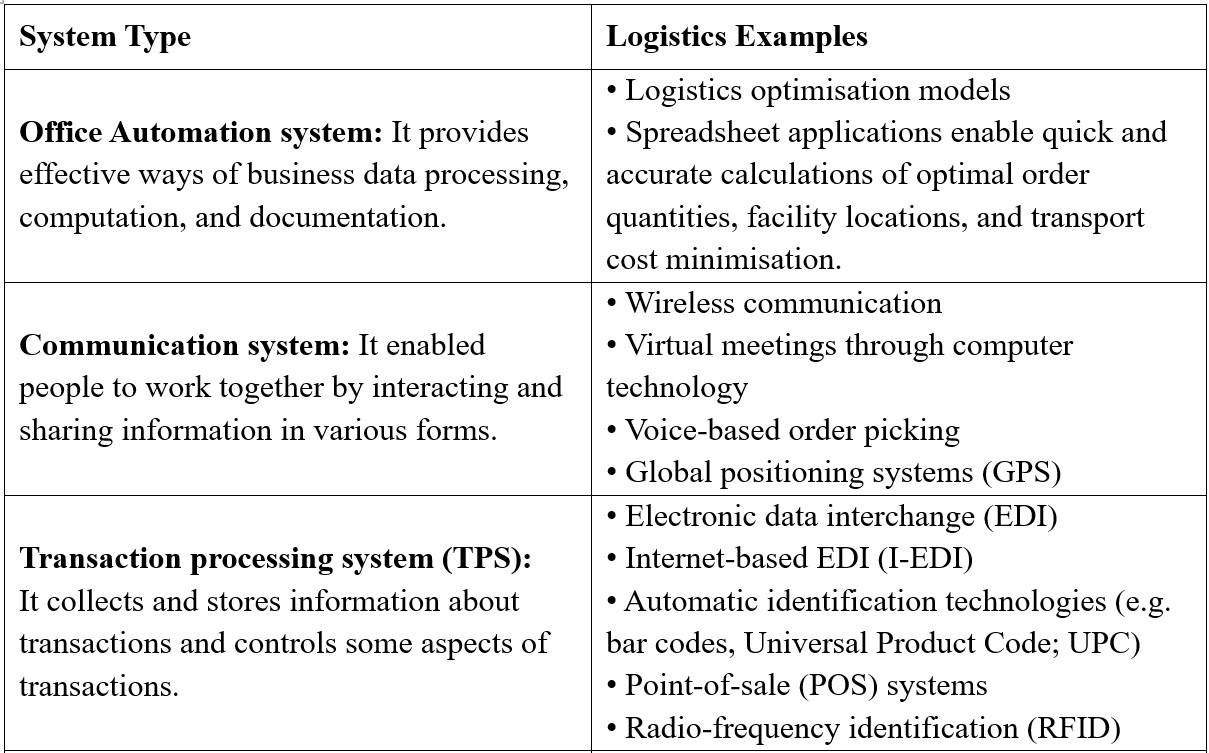
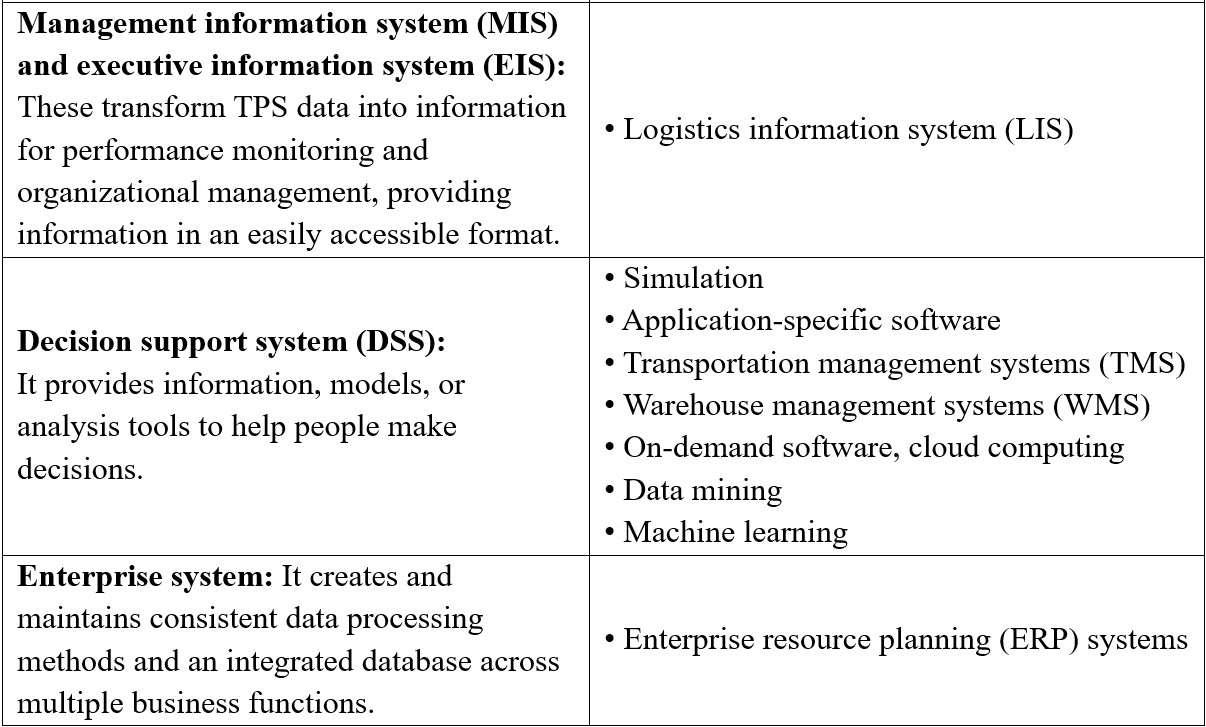
As shown in figure 1, various information technologies are derived from the six general types of information management systems and are used widely in logistics and supply chain management. However, there are several challenges and risks associated with the use of IT in logistics and supply chain. The Information Technology Challenge includes human resources issues. Employees’ resistance to new technologies is the most significant cause of failure in implementing information technology (Chopra & Meindl, 2013, p. 496; Murphy & Knemeyer, 2018, p. 54). Security concerns may be another severe risk in the use of IT. According to Murphy and Knemeyer (2018), the average company’s proprietary information theft is estimated to cost about $300,000 a year (p. 54).
3.3 Information technology in logistics operations of Walmart
Walmart is one of the most successful companies based on the availability and analysis of information through innovative information technology (Chopra & Meindl, 2013, p. 489). To achieve their business strategy, ‘Every Day Low Price (EDLP)’, Walmart actively introduced IT (Chiles & Dau, 2005, p. 104).
Walmart has built the world’s most immense private cloud that can process more than 2.5 petabytes (1 petabytes=1 gigabytes×1,000,000) of data per hour, which enabled Walmart to retain 100% control over its resources and provided more secure cloud network (Kemal, 2019, p. 1-2; Minch, 2015, p. 1522). It reduces the processing time of a large amount of data from 2-3 weeks to 20-30 minutes. Along with the cloud system, Walmart has built the world’s largest private integrated satellite communication network for effective and efficient management and operation control of its stores and supply chain (Garcia, 2020, p. 4-5).
Walmart, a multinational retail company responsible for ensuring the freshness of food products, introduced a blockchain technology based on Hyperledger Fabric for better traceability and transparency of its decentralised food supply ecosystem and to tackle the risks of any food-borne problems (Hyperledger, 2019; Singh et al., 2020). Using this technology system, the time required for tracing the provenance of a product decreased significantly from 7 days to 2.2 seconds (Hyperledger, 2019).
In addition, Walmart has implemented the Internet of Things to manage food safety. IoT collects data from sensors at each point in the supply chain, such as farms, transportation, warehouses, and markets, to provide information on the status of the products (Singh et al., 2020). Through exploiting the blockchain and IoT technologies, risks of food contamination or related problems can be detected quickly or prevented more effectively (Kamath, 2018, p. 3). Many other information technologies are in use to tackle challenges and for better managerial operation, which are listed in Figure 3.
Figure 3 Other types of IT in the logistics/SCM of Walmart

4.0 Supply Chain Management (SCM)
4.1 Concept of the SCM
Supply Chain Management is a relatively new concept that appeared first in 1990 (Christopher, 2016, p. 3; Murphy & Knemeyer, 2018, p. 96). SCM includes planning and managing all activities involved in sourcing and procurement, conversion, and logistics management activities to deliver goods and services to end consumers (CSCMP, 2013, p. 187; Sadler, 2007, p. 4). Achieving coordination with the parties in the supply chain, such as suppliers, intermediaries, third-party service providers, and customers, is also a part of it (Christopher, 2016, p. 3).
Essentially, SCM is a holistic approach to management across the boundaries of companies and processes as it is a combination of managerial activities on strategic decision making, manufacturing operations, marketing, financial transactions, customer services, product design, sales, and information technology (Grant et al., 2017, p. 9; Murphy & Knemeyer, 2018, p. 97; Slack & Brandon-Jones, 2019, p. 410; Rushton et al., 2017, p. 57).
The form of supply chain may be different according to the number of participating parties. The more parties involved in the supply chain, the more complex the structure of the supply chain becomes (Murphy & Knemeyer, 2018, p. 97). However, since most supply chains take the form of networks, the term ‘supply networks’ or ‘supply web’ may be more appropriate to describe the structure of supply chains (Chopra & Meindl, 2013, p. 2). Figure 4 and Figure 5 demonstrate the different forms of the supply chain and the supply network/web respectively.
Figure 4 Different forms of supply chain

Figure 5 Supply network/web
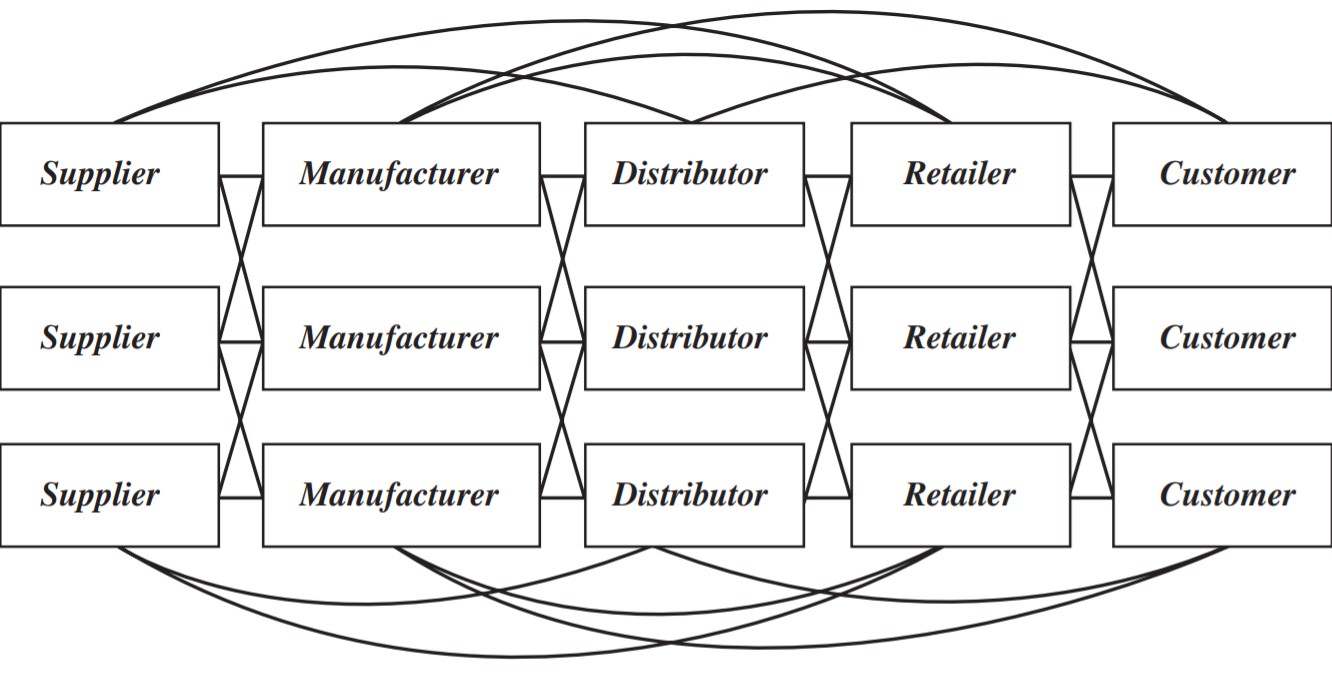
4.2 SCM of Walmart
Walmart operates approximately 10,526 stores in 24 countries and eCommerce websites and has over 2.3 million employees (Walmart, n.d.) and an extensive supply chain that consists of 2,800 suppliers around the world (Best, 2021). Walmart uses many cutting-edge information technologies to manage its massive supply chain and implements various operations management and productivity strategies.
It is no overstatement to say that effective inventory management played a significant role in Walmart’s supply chain management success. Walmart implemented a vendor-managed inventory model in which suppliers access data from the company’s information systems and decide when to convey supplementary products to Walmart. At the same time, the actual conveyance of goods from warehouses to stores is monitored and controlled by the company. Through this inventory management model, Walmart could minimise delays in overall supply chain movement and the costs for inventory management (Lin, 2019, p. 757).
Walmart has four different types of inventory with different roles in the supply chain: Finished Good Inventory, Transit Inventory, Buffer Inventory, Anticipation Inventory (Greenspan, 2019). The roles of each type of inventory are in Figure 6.
Figure 6 Walmart’s Different Types of Inventory and Roles

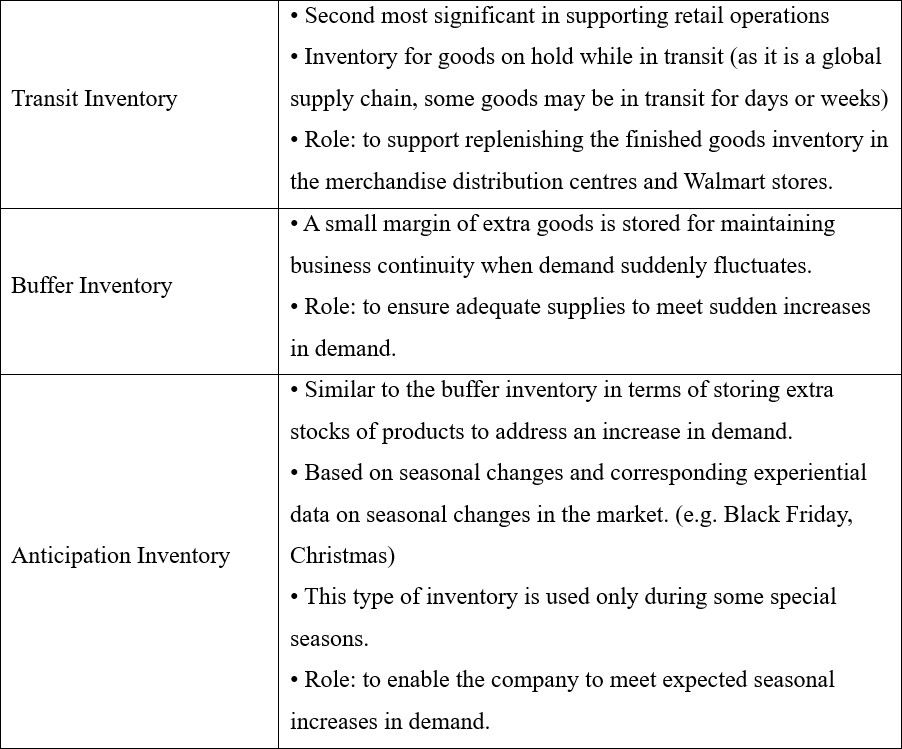
Besides effective inventory management, there are other strategies implemented for better SCM and productivity of Walmart: Location Strategy, Layout Design and Strategy, Scheduling. Details of each operational strategies are in Figure 7.
Figure 7 Operational Strategies of Walmart
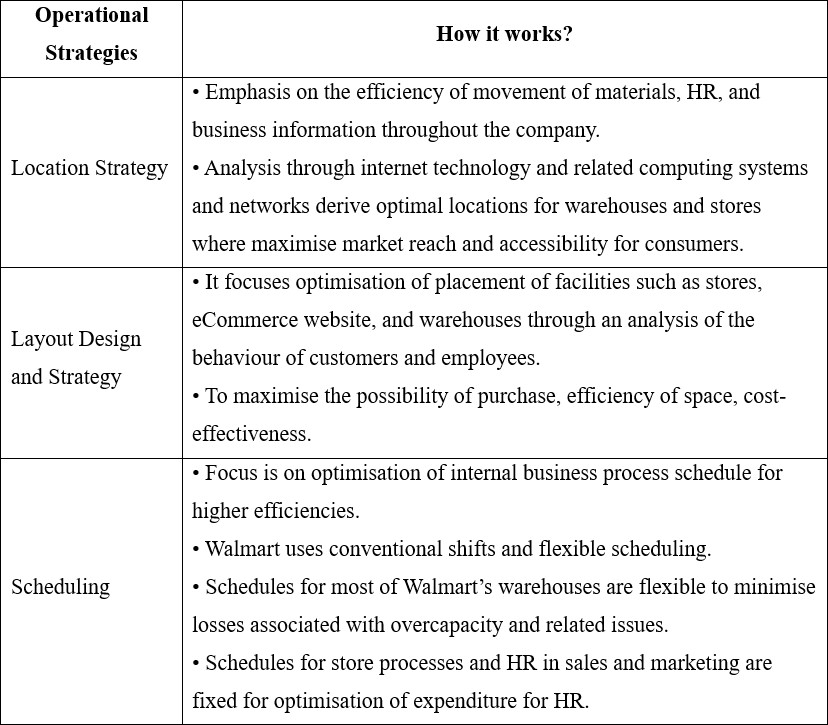
The distribution operation of Walmart is one of the largest worldwide, operating a fleet of 6,500 tractors, 55,000 trailers, and more than 7,000 drivers. Walmart maintains in-house logistics utilising a private fleet of trucks and drivers, enabling the company to transport goods from its distribution centres to store shelves with minimum time spent.
The logistics hubs of Walmart map out the optimal routes for drivers to minimise the number of “empty kilometres” and monitor and control the entire shipping process. Through this strategy, Walmart observed a reduction in fuel usage and total driving distance and, most importantly, an increase in the amount of merchandise in one delivery (West et al., n.d.).
As shown above, Walmart can effectively and efficiently manage its extensive and complex supply chain by implementing various operational strategies and technologies with different roles and purposes to its logistics systems.
5.0 Conclusion
The way information technology improves the logistics systems operations and the supply chain management and how Walmart exploits the technologies to maximise the efficiency in its administration are covered throughout this paper. It is evident that information technology has a significant impact on logistics operations and has enabled Walmart to manage its supply chain and risks associated with food contamination, potential fluctuation in demand, scheduling and more. As the advancement of information technology is taking place rapidly, it is expected that there will be much more opportunities for Walmart to develop and expand its business further by adopting those technologies into its operations.
Reference List
Best, R. (2021). 5 Key Suppliers of Walmart. Investopedia. https://www.investopedia.com/articles/insights/050116/walmart-stock-analyzing-5-key-suppliers-wmt.asp
Bode, C., Kemmerling, R., & Wagner, S. M. (2013). Internal versus External Supply Chain Risks: A Risk Disclosure Analysis. Supply Chain Safety Management, 109–122. https://doi.org/10.1007/978-3-642-32021-7_6
Chiles, C. R., & Dau, M. T. (2005). An Analysis of Current Supply Chain Best Practices in the Retail Industry with Case Studies of Wal-Mart and Amazon.com [MSc Thesis]. In (pp. 1–188). Massachusetts Institute of Technology.
Chopra, S., & Meindl, P. (2013). Supply Chain Management: Strategy, Planning, and Operation (5th ed.). Pearson.
Christopher, M. (2016). Logistics & Supply Chain Management (5th ed.). Pearson Education Limited.
Council of Supply Chain Management Professionals. (2013). Supply Chain Management Terms and Glossary. CSCMP; https://cscmp.org/CSCMP/Educate/SCM_Definitions_and_Glossary_of_Terms.aspx
Garcia, G. (2020). Information Systems Utilization of an Organization: The Case of Walmart Inc. In (pp. 1–15). https://doi.org/10.13140/RG.2.2.34979.81447
Grant, D. B., Trautrims, A., & Chee Yew Wong. (2017). Sustainable Logistics and Supply Chain Management: Principles and Practices for Sustainable Operations and Management. Kogan Page Ltd.
Greenspan, R. (2019). Walmart’s Inventory Management. Panmore Institute. http://panmore.com/walmart-inventory-management
Hyperledger. (2019). How Walmart Brought Unprecedented Transparency to the Food Supply Chain with Hyperledger Fabric (pp. 1–7). https://www.hyperledger.org/wp-content/uploads/2019/02/Hyperledger_CaseStudy_Walmart_Printable_V4.pdf
Issaoui, Y., Khiat, A., Bahnasse, A., & Ouajji, H. (2019). Smart Logistics: Study of the Application of Blockchain Technology. Procedia Computer Science, 160, 266–271. https://doi.org/10.1016/j.procs.2019.09.467
Kamath, R. (2018). Food Traceability on Blockchain: Walmart’s Pork and Mango Pilots with IBM. The Journal of the British Blockchain Association, 1(1), 1–12. https://doi.org/10.31585/jbba-1-1-(10)2018
Kemal, M. (2019). Beneficial uses of Cloud Computing Service and Deployment Models. https://www.researchgate.net/publication/335318594
Kotler, P., Armstrong, G., & Opresnik, M. O. (2020). Principles of Marketing (18th ed.). Pearson Education Limited.
Lin, R. (2019). The Importance of Successful Inventory Management to Enterprises-A Case Study of Wal-Mart. Francis Academic Press, 755–758. https://doi.org/10.25236/mfssr.2019.154
Minch, R. P. (2015). Location Privacy in the Era of the Internet of Things and Big Data Analytics. 2015 48th Hawaii International Conference on System Sciences, 1521–1530. https://doi.org/10.1109/HICSS.2015.185
Murphy, P. R., & Knemeyer, A. M. (2018). Contemporary Logistics (12th ed.). Pearson Education Limited.
Rodrigues, V. S., Stantchev, D., Potter, A., Naim, M., & Whiteing, A. (2008). Establishing a Transport Operation Focused Uncertainty Model for the Supply Chain. International Journal of Physical Distribution & Logistics Management, 38(5), 388–411. https://doi.org/10.1108/09600030810882807
Rushton, A., Croucher, P., & Baker, P. (2017). The Handbook of Logistics and Distribution Management: Understanding the Supply Chain (6th ed.). Kogan Page.
Sadler, I. (2007). Logistics and Supply Chain Integration. Sage Publications Ltd.
Singh, V., Kaur, M., Vashishth, P., & Kumar, S. (2020). Walmart Strategy: A Combination of Innovation, Technologies, and Acquisitions. GreyB. https://www.greyb.com/walmart-strategy/#Walmarts-Strategies-to-Overcome-Challenges
Slack, N., & Brandon-Jones, A. (2019). Operations Management (9th ed.). Pearson.
Smithson, N. (2020). Walmart’s Operations Management: 10 Strategic Decisions & Productivity. Panmore Institute. http://panmore.com/walmart-operations-management-10-decisions-areas-productivity-case-study-analysis
The Chartered Institute of Logistics and Transport. (2012). Logistics Management. CILT. https://ciltuk.org.uk/Careers/Online-Careers-Service/Career-Pathways/Logistics-Management
Tummala, R., & Schoenherr, T. (2011). Assessing and Managing Risks Using the Supply Chain Risk Management Process (SCRMP). Supply Chain Management: An International Journal, 16(6), 474–483. https://doi.org/10.1108/13598541111171165
Walmart. (n.d.). Location Facts. https://corporate.walmart.com/our-story/our-locations?multi=false
Wang, J. (2012). Information Technologies, Methods, and Techniques of Supply Chain Management. Business Science Reference.
West, C., Madigan, M., Webb, L., Wiercioch, V., Thomas, D., & Silva, A. (n.d.-a). EDI System. Walmart. https://walmartsupplychain.weebly.com/edi-system.html
West, C., Madigan, M., Webb, L., Wiercioch, V., Thomas, D., & Silva, A. (n.d.-b). Logistics. Walmart. https://walmartsupplychain.weebly.com/logistics.html
West, C., Madigan, M., Webb, L., Wiercioch, V., Thomas, D., & Silva, A. (n.d.-c). RFID Technology. Walmart. https://walmartsupplychain.weebly.com/rfid-technology.html
